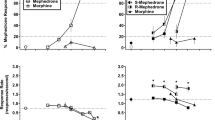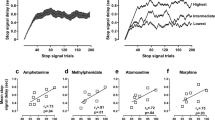Abstract
The present study investigated effects of methylphenidate on spatio-temporal distributions of responses generated by a fixed interval 60-s schedule of reinforcement. A response panel with 20 different response locations (holes) made it possible to distinguish effects of the drug on the procedurally-correct response (correct according to the contingencies) and effects on other topographically similar responses acting as functionally-adequate responses. Detailed flow charts show how the dynamics of responding changed with dose and segment of the fixed interval. The number of holes visited was increased after low and medium doses, but decreased after high doses. The spatial differences between responses in the initial and the final parts of the fixed interval gradually disappeared after 6 mg/kg or higher doses as the functionally-adequate responses moved to earlier segments of the fixed interval. Few results could, however, be described as response rate dependent. Distributions of responses around the correct hole illustrated differences between procedurally-correct and functionally-adequate classes. The number of holes included in the latter class changed by dose in an inverted U-shaped fashion. Perseverations and stereotyped responding increased with increasing dose. Most of the effects may be described as motor stimulatory. One way of explaining the stimulatory effect is in terms of a lengthened delay-of-reinforcement gradient. The rate-dependent effect of methylphenidate on the procedurally-correct class after some doses may have been due to the combined effects of a lengthened delay gradient increasing the response rates early in the interval and interference from perseverations having their most detrimental effects on the high rates late in the interval.
Similar content being viewed by others
References
Boren JJ, Moerschbaecher JM, Whyte AA (1978) Variability of response location on fixed-ratio and fixed-interval schedules of reinforcement. J Exp Anal Behav 30:63–67
Catania AC (1971) Reinforcement schedules: the role of responses preceding the one that produces the reinforcer. J Exp Anal Behav 15:271–287
Catania AC (1973) The concept of the operant in the analysis of behavior. Behaviorism 1:103–116
Catania AC, Keller K (1981) Contingency, contiguity, correlation, and the concept of causation. In: Harzem P, Zeiler MD (eds) Predictability, correlation, and contiguity. Wiley, New York, pp 125–167
Catania AC, Sagvolden T, Keller KJ (1988) Reinforcement schedules: retroactive and proactive effects of reinforcers inserted into fixed-interval performances. J Exp Anal Behav 49:49–73
Dews PB (1955) Studies on behavior. III. Effects of pentobarbital, methamphetamine and scopolamine on performances in pigeons involving discriminations. J Pharmacol Exp Ther 115:380–389
Dews PB (1958) Studies on behavior. IV. Stimulant actions of methamphetamine. J Pharmacol Exp Ther 122:137–147
Dews PB (1960) Free-operant behavior under conditions of delayed reinforcement: I. CRF type-schedules. J Exp Anal Behav 3:221–234
Dews PB (1962) The effect of multiple SD periods on responding on a fixed-interval schedule. J Exp Anal Behav 5:369–374
Dews PB, Wenger GR (1977) Rate-dependency of the behavioral effects of amphetamine. In: Thompson CT, Dews PB (eds) Advances in behavioral pharmacology, vol 1. Academic Press, New York, pp 167–227
Dixon WJ, Brown MB, Engleman L, Frane JW, Hill MA, Jennrich RI, Toporek JD (1981) BMDP Statistical Software. University of California Press, Berkeley, California
Ettenberg A, Koob GF, Bloom FE (1981) Response artifact in the measurement of neuroleptic-induced anhedonia. Science 213:357–359
Evenden JL, Robbins TW (1985) Effects of d-amphetamine, chlordiazepoxide and alpha-flupenthixol on food-reinforced tracking of a visual stimulus by rats. Psychopharmacology 85:361–366
Ferster CB, Hammer C (1965) Variables determining the effects of delay of reinforcement. J Exp Anal Behav 8:243–254
Fog R (1969) Stereotyped and non-stereotyped behavior in rats induced by various stimulant drugs. Psychopharmacology 14:299–304
Goodman LS, Gilman A (1985) The pharmacological basis of therapeutics, 7th edn. Macmillan, New York
Grilly DM (1977) Rate-dependent effects of amphetamine resulting from behavioral competition. Neurosci Biobehav Rev 1:87–93
Hill RT (1970) Facilitation of conditioned reinforcement as a mechanism of psychomotor stimulation. In: Costa E, Garattini S (eds) Amphetamines and related compounds. Raven Press, New York, pp 781–795
Iversen IH (1982) Contiguity and response generalization. Behav Anal Lett 2:185
Iversen IH, Mogenson J (1984) d-Amphetamine affects one-trial appetitive conditioning in rats. Paper presented at the 10th Annual Convention of the Association for Behavior Analysis
Kelleher RT, Morse WH (1968a) Determinants of the specificity of behavioral effects of drugs. Ergeb Physiol 60:1–56
Kelleher RT, Morse WH (1968b) Schedules using noxious stimuli. J Exp Anal Behav 11:819–838
Lyon M, Robbins TW (1975) The action of central nervous system stimulant drugs: a general theory concerning amphetamine effects. In: Essman W, Valzelli L (eds) Current developments in psychopharmacology. Spectrum, New York, pp 79–163
Pechnick R, Janowsky DS, Judd L (1979) Differential effects of methylphenidate and d-amphetamine in the rat. Psychopharmacology 65:311–315
Randrup A, Munkvad I (1967) Stereotyped activities produced by amphetamine in several animal species and man. Psychopharmacologia 11:300–311
Rutter M (1983) Developmental neuropsychiatry. Churchill Livingstone, Edinburgh
Sagvolden T, Jenssen JR, Brorson IW (1983) Rate-dependent effects of methylphenidate (Ritalin) on fixed-interval behavior in rats. Scand J Psychol 24:231–236
Sanger DJ, Blackman DE (1976) Rate-dependent effects of drugs: a review of the literature. Pharmacol Biochem Behav 4:73–83
Schwartz B (1980) Development of complex, stereotyped behavior in pigeons. J Exp Anal Behav 33:153–166
Schwartz B (1982) Failure to produce response variability with reinforcement. J Exp Anal Behav 37:171–181
Stein L (1964) Amphetamine and neural reward mechanisms. In: Steinberg H, de Reuck AVS, Knight J (eds) Animal behavior and drug action. Churchill, London, pp 91–118
Stretch R, Skinner N (1967) Methylphenidate and stimulus control of avoidance behavior. J Exp Anal Behav 16:89–104
Vogel R, Annau Z (1973) An operant discrimination task allowing variability of reinforced response patterning. J Exp Anal Behav 20:1–20
Author information
Authors and Affiliations
Additional information
Offprint request to: T. Sagvolden
Rights and permissions
About this article
Cite this article
Sagvolden, T., Sl»tta, K. & Arntzen, E. Low doses of methylphenidate (Ritalin) may alter the delay-of-reinforcement gradient. Psychopharmacology 95, 303–312 (1988). https://doi.org/10.1007/BF00181938
Received:
Revised:
Issue Date:
DOI: https://doi.org/10.1007/BF00181938




